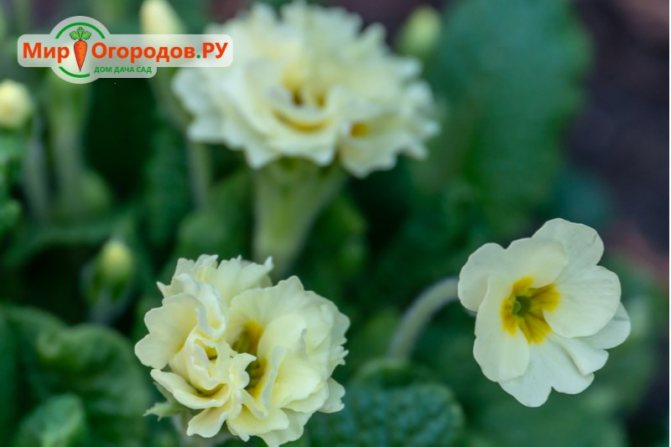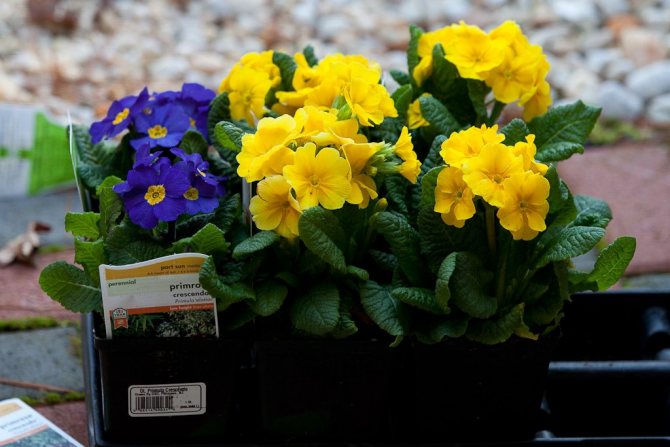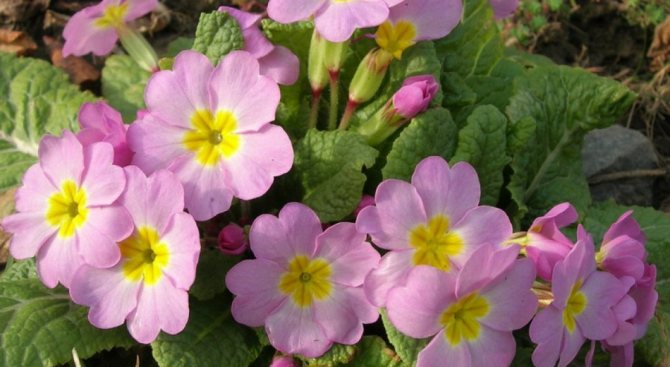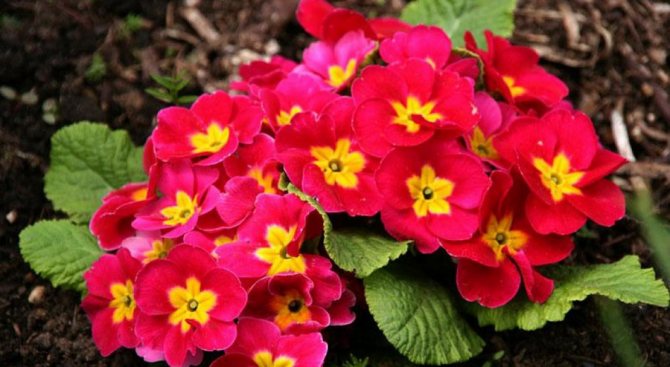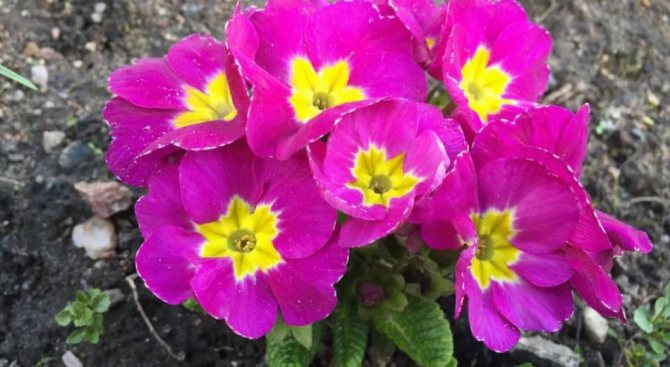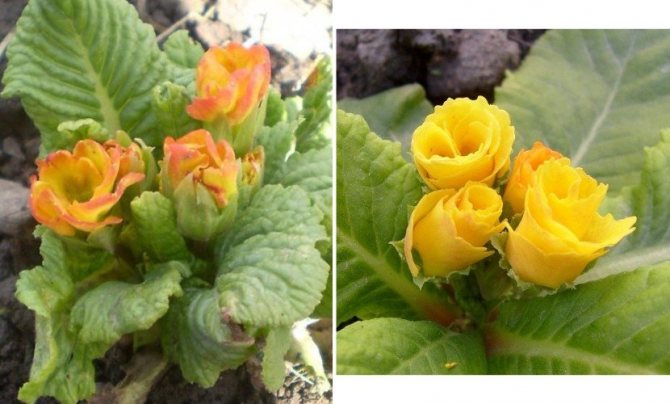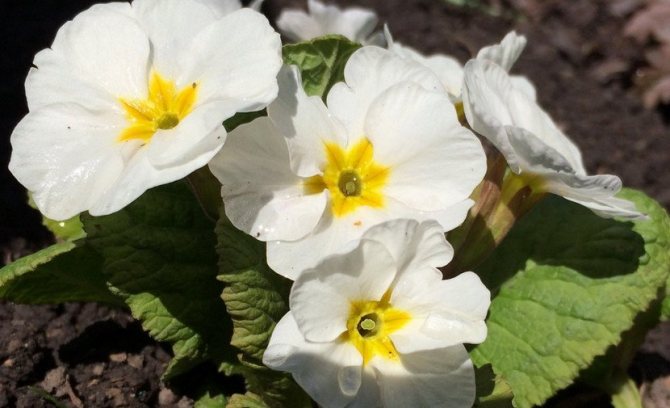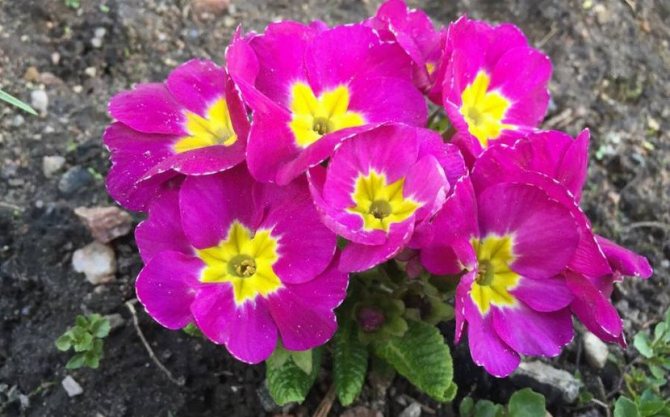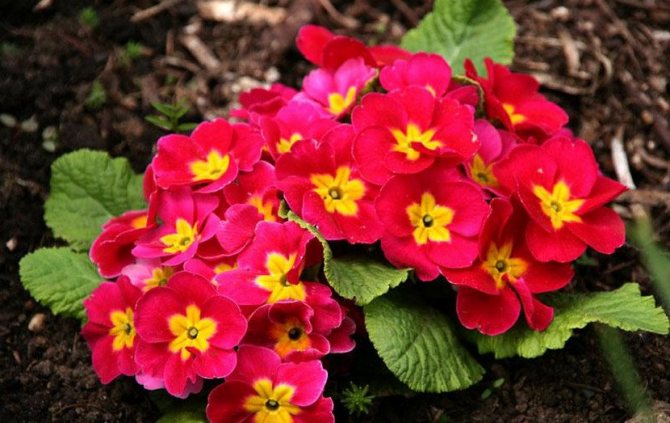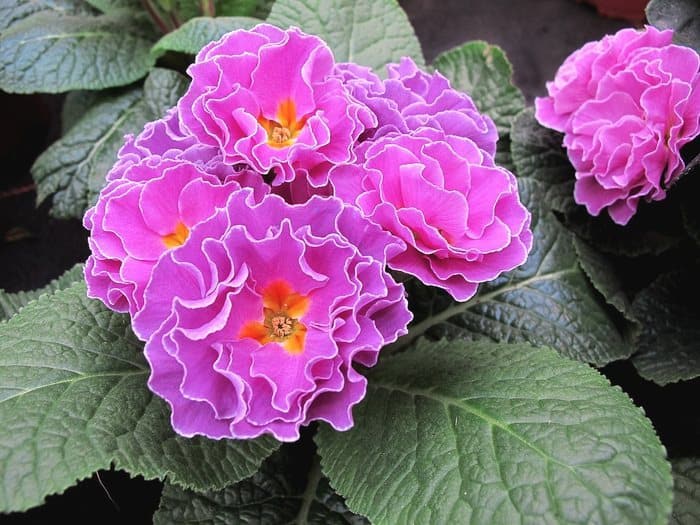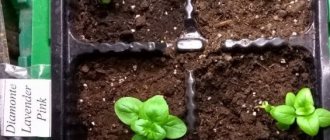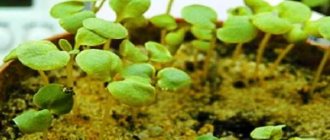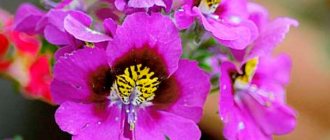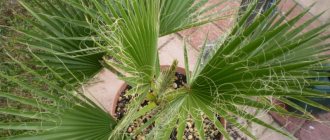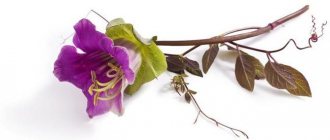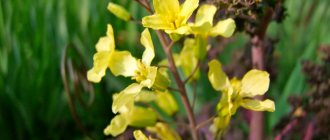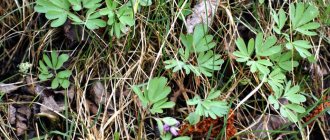I had a funny story with this flower. A friend gave me a primrose, but forgot to say the name of the plant. And I, a “super experienced florist”, naively believed for four months that I was growing a new rare Saintpaulia variety! In general, I worked, did not look closely ...
And only when a friend called and asked if I had transplanted her gift into the garden, I suspected something was wrong and looked more closely at the flower. But that was once - now I know everything about primroses, and I myself give them away to friends, having grown them from seeds with my own hands.
Primrose description
Primroses are legendary and very diverse plants, which are united only by their small size and growth form. Herbaceous perennials with large pubescent leaves and heads gathered in a basal rosette, shields and umbrellas of inflorescences of touching bright flowers in a flower bed look like a tiny, but luxurious accent.
Representatives of the genus primrose (Primula) - one of the most beloved spring flowering plants. But they are so diverse that among the many species there are both the classic inhabitants of flower beds and those beauties who are ready to settle near water bodies or bloom at atypical times - in summer. The genus of primroses includes about half a thousand species of plants, and all of them are equally interesting and beautiful.
For convenience, they are divided into sections according to the main decorative features. And if in the case of the legendary toothed-leaved, cortex-shaped primroses it is easy to understand, then other names are far from so eloquent. It is much more practical to classify charming crumbs by type of flowering - capitate, candelabra, bell-shaped, cushion-shaped and umbrella primroses offer a selection of amazing varieties with different colors and sizes.
The seed method of reproduction is equally difficult for all primroses, without exception, most species need stratification, and the conditions for their germination most often differ significantly.
Common varieties
Primrose transplant: at home and breeding methods
All primrose varieties are divided into 30 sections. The following are the most popular types and varieties:
Ordinary
Grows in central and southern Europe. Places of distribution: forest edges, alpine meadows. The rhizome is short with thick roots, like laces. Lanceolate leaves 25 cm, width - 6 cm. Peduncles can be from 6 to 20 cm. Flowers are solitary, pale yellow or white. The petals are wide, divided into two lobes. Flowering begins in March. Sometimes you bloom again in September.
Common varieties:
- Virginia: white flowers with a pale yellow throat;
- Giga White: snow-white flowers;
- Cerulea: The flowers are blue with a yellow fauces.

Common view
High
Origin from the Carpathians and the southern and northern parts of Western Europe. Leaves are oval in shape with a finely toothed edge. The length of the leaf blades is 5-20 cm, the width is 2-7 cm. The leaves are strongly tapering towards the petiole. On the front side, the veins on the leaves are depressed, and on the seamy side they are convex. The inflorescences are in the shape of an umbrella. They consist of 5-15 flowers. The diameter of the flowers is 2 cm. Their color is pale yellow. Peduncle height 10-35 cm. Bloom in April for 60 days.
Varieties of this type:
- Duplex: cherry blossoms, diameter 25 cm;
- Rosea: flowers are dark pink;
- Gele Farben: lavender inflorescences, diameter 95 mm;
- Gold Grand: brown buds, diameter 25 mm.
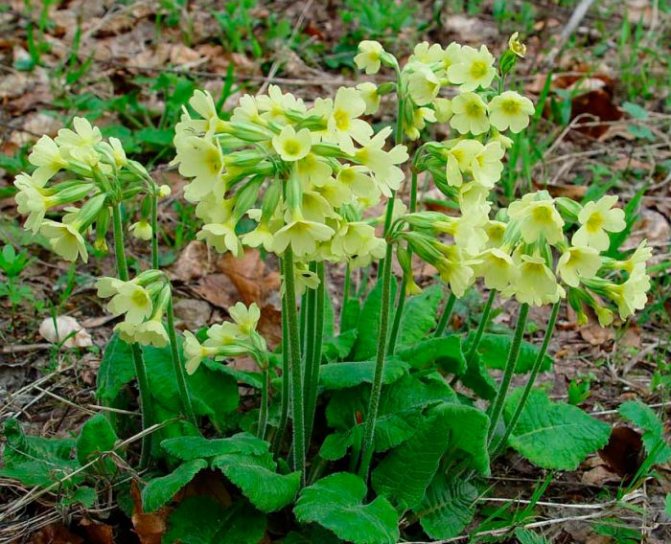

View high
Siebold
Blooms in June. Flowers can be pink or lilac. The inflorescences look like an umbrella.
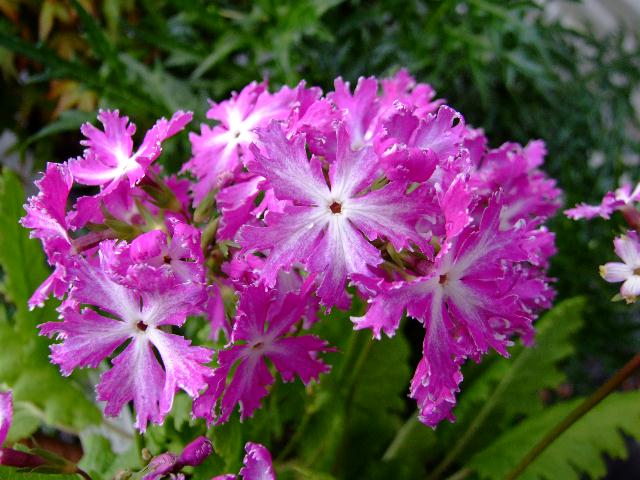

Siebold's view
Spring
Also called Medicinal. Origin: Europe. Leaves are ovoid and wrinkled. Their length is 20 cm, and their width is 6 cm. From the front, the veins are depressed, and from the back they are convex. Flowers are yellow with an orange spot at the base. They can be terry or smooth. Blooms from April to June.


Spring view
Self-collection of primrose seeds and their selection for sowing
Primrose seeds ripen in fruit pods. They are very small, spherical or cylindrical, with a dark color, up to 2 thousand seeds "fit" in 1 g. But such fertility does not at all mean that you can get a huge number of plants. Seed propagation is very difficult and requires patience and endurance.
But it is better to hurry with sowing primrose: the seeds, even before spring sowing, when stored under ideal conditions, lose their germination by 40%. But the most important thing is that the time it takes for them to germinate increases dramatically within a few weeks after collecting the seeds. Therefore, it is best to use primrose seeds immediately after harvesting and lightly drying (or even without it at all).
The seeds ripen in July and August, they are harvested when the capsules are slightly open, but not yet fully opened (to prevent spillage and avoid the need to constantly monitor the capsules, it is better to tie the capsules with a transparent cloth). It is only necessary to keep the seeds cool, the temperature even at 20 degrees Celsius is considered very high for primrose seeds.
If you want to experiment with self-breeding new varieties and colors, then you can resort to the cross-pollination method. To do this, during flowering, you just need to arm yourself with a brush and transfer pollen from different bushes and different varieties to others.
Experienced flower growers always recommend keeping primrose seeds from their own garden, carefully collecting them annually and keeping them cool until spring. So you will always have a chance to grow new plants if your favorite bushes and varieties die as a result of winter. And for some primroses, seed reproduction is the only option that will help you observe flowering in all its glory. We are talking, first of all, about the Japanese primrose, which blooms magnificently only at the age of two and three years and requires periodic replacement with new plants grown from seeds.
Today, a huge number of primrose seeds are on sale, and the choice can be made between mixtures of varieties and individual varieties, and among the varieties there are both conventional and hybrid. When buying the latter, it should be borne in mind that plants may not retain varietal characteristics or retain them only partially. It is better to make the choice based on the aesthetic qualities, sizes and characteristics of the agricultural equipment recommended by the manufacturer. But the main attention should be paid to studying the timing of the collection of seeds and information about the period of their recommended use.
The fresher the seeds are, the better. But be prepared for unpleasant surprises: the same seeds from the same batch in different stores may germinate in different ways. You will not find information about the temperature of their storage in the store, so there are no guarantees that primroses will rise at all. The newer and more expensive the variety, the greater the risk. And in fact, 99% of the success rate still depends only on the seeds, and not on the specific agricultural technology for their germination.


Primrose seeds. <>
The subtleties of growing primroses from seeds
Some people sow seeds directly into the ground.
However, many gardeners (myself included) believe: it is better to get a little confused and apply the seedling method. More plants will grow this way.
For this, the seeds of the variety you have chosen are bought in February. And be patient: the seeds will take a long time to sprout, and the sprouts will germinate very slowly.
Stratification
- Prepare a tray with a lid, fill it with peat mixed with vermiculite (or other light substrate). Moisten the soil a little, scatter seeds over its surface.
- Tighten the top of the soil with cling film, a bag or cover with a lid.
- Place the tray in a cool place. It is important that the temperature in it does not fall below zero. A cold closed balcony, basement, refrigerator will suit you.
- It is necessary to keep the seeds in such a place from 10 to 30 days. Your goal: imitation of the natural environment (so that the seeds "think" that they fell into the ground from the mother bush and overwintered).
You can see all the step-by-step work on sowing seeds for stratification in this video:
Germinating seeds
- Transfer the container to a bright place. The room should be about 12-18 degrees, no more. For seeds, this is an imitation of spring.
- Keep them exposed to light for up to a month. From time to time, look through the transparent lid for seedlings. If you notice that a lot of condensation has accumulated on the surface of the film / lid, quickly lift it up and wipe it off.
- When the seedlings hatch, start hardening them. To do this, one day remove the lid for 5 minutes, the next - for 10 ... If the soil dries out, gently sprinkle it. You can also water the soil, but so as not to flood.
- At first, each sprout will grow 2 fake leaves (cotyledons). Then the real ones will appear. As soon as you see that all sprouts have 2 real leaves, you can dive (transfer) them to separate pots. The most convenient way is to use disposable cups.
How primrose seedlings look and how the pick occurs, you will see here:
These "guys" can be transferred to the flowerbed when the weather is steadily warm.
By the way, if your variety does not bloom in the year of vegetation (germination), a box or pots of seedlings can be kept in the house right up to the spring of next year. Until that time, the plant will get as strong as possible and will be ready for an independent life in the open field.
Sowing primrose seeds immediately after harvest and winter sowing
If you have the opportunity to sow immediately after harvesting, then the seeds must be sown in high-quality garden soil in boxes dug in the beds or in open beds. The soil is poured abundantly before sowing. Sowing is carried out shallow, in grooves or superficially. Since sowing is carried out in the summer, the plant needs to be provided with mulching and constant watering. Thinning is carried out after the release of the second pair of true leaves. Young plants are protected for the winter with a thick layer of dry mulch (up to 10 cm, preferably from dry leaves).
Sowing in winter is also best done in boxes, not earlier than stable night frosts come, and the soil begins to freeze. For primrose, it is imperative to ensure the presence of not only a sufficiently large number of drainage holes, but also the laying of a thick layer of drainage materials at the bottom of the boxes. Even before winter, primrose seeds are sown superficially, only slightly covering them with soil from above, but sowing is carried out as thickly as possible.
As protection from weeds, soaking and snow, the crops are covered with any non-woven material or film. The boxes are left in a semi-shaded place until spring, trying to remove the lutrasil immediately after the snow melts. Young primroses will need regular watering; even a short-term drought should not be allowed for seedlings.


Seedlings of primrose seedlings.
Home care
Kalanchoe reproduction: options and methods at home
It is quite simple to care for a primrose at home. It is better to keep it where there is good lighting. It is also important not to overflow the plant. Otherwise, it can get sick with rot.


Primrose is not demanding to care for
Humidity
There are no specific requirements for air humidity. However, if the humidity is too low, the edges of the leaves begin to dry. In this case, it is required to spray the leaves with soft water.
Temperature
The room where the plant lives should be cool. When blooming, the recommended temperature is 12-15 degrees.
Watering
When flowering, watering is necessary often, as it is required that the soil is constantly moistened. However, it is worth remembering that it is impossible to fill the flower, as this will provoke the development of rot on the roots. After flowering, water should be moderate.
Important! According to the advice of experienced flower growers, when watering, it is required to use soft water.
Top dressing
Top dressing is carried out after the buds have formed. Complex formulations with microelements are used as fertilizers. Top dressing is carried out twice a month, before flowering ends. If you fertilize the flower before the buds appear, then all the power will go into the foliage. After the flowers fall off, the plant is transplanted into open ground or into another pot.
The soil
To plant a plant, an earth mixture is used. A good mixture should consist of leafy soil, peat soil, sand. Everything is taken in the same proportions. A drainage layer is also required.
Soil and containers for planting primrose
For growing primrose, it is better to use fertile, loose and rather rough in structure soil. For sowing seeds, either a classic seedling substrate is used, or a mixture is prepared independently of equal shares of soddy soil and sand and a double share of leafy soil. There is no need to sift the soil before sowing, but after filling the containers, it must be carefully leveled, making sure that there are no grooves and pits (the seeds are small and easily fall through).
The containers are easy to pick up. For primroses, classic seedling containers with a height of 5 to 7 cm are suitable. When sowing in large containers, it is important to make sure that there are high-quality drainage holes. Instead of a "common" box, you can sow primroses in small pots, cassettes, containers with cells.
Ear variety
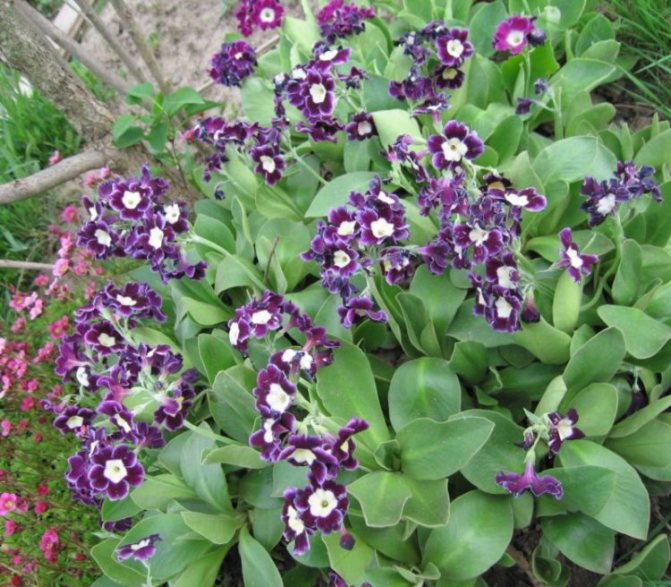

When to plant? For good germination, the seeds can be sown in the fall. If you plan to sow ear primrose seeds in the springtime, you need to do it in February or March. Before sowing, you need to hold the seeds in the refrigerator, and then transfer them to a warm place. It is necessary to alternate storage at low and high temperatures.
The substrate can be made from:
- Humus leaves.
- Sod land.
- Rack sand.
Your next actions will be like this:
- Place the seeds over the surface, fill containers with them and sprinkle with earth.
- Cover the container with glass or plastic.
- Move containers to a heated balcony.
- When sprouts appear, move it to another room.
- If necessary, moisten the soil, you need to shade the seedlings from the sun's rays.
- Picking into pots is carried out when 4 leaves appear on the seedlings.
- Disembarkation on a flower bed or in a flower garden is carried out in June or September.
Sowing dates of primrose seeds and pre-treatment
The optimal time to sow primrose seeds is considered to be the time of their collection: the faster the seeds fall into the soil, the greater the chance of success. Accordingly, ideally, sowing is carried out in July or August, but for this option, agricultural technology and plant care change significantly. If you want to get classic seedlings, then the sowing time is limited to February (if it is possible to organize artificial supplementary lighting, sowing can be carried out in January and December). The soil before sowing is by no means watered for all species that need stratification.
To prevent the spread of fungal diseases, before sowing, self-collected primrose seeds can be additionally soaked in a weak fungicide solution or a weak solution of potassium permanganate (a procedure in 20 minutes is quite enough).
Terry roseanna
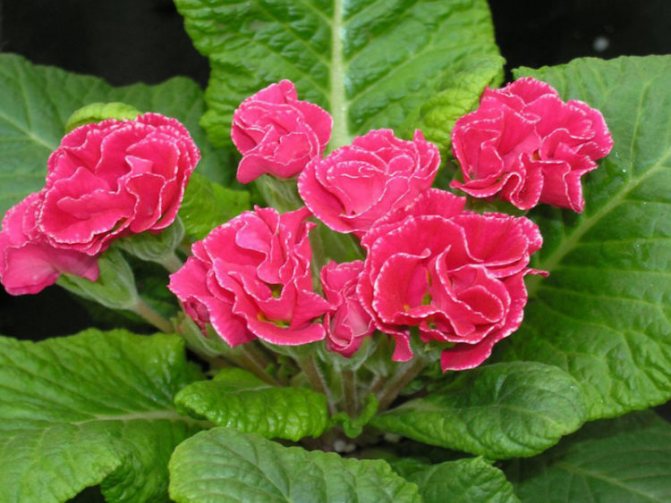

Terry rosanna without stems is more difficult to propagate than other species. Seeds are more expensive, and there are only 5 of them in one package. The mesmerizing beauty of primroses covers the material and moral costs of flower growers.
For sowing, you need to use fertile land. The seeds are buried by 2 mm, and then the soil is slightly compacted... Seed shoots will appear in 2 months. Development is slow, the seedlings grow for a long time. It is important to wait for germination and provide proper care for the seedlings.
Now you know how to plant a flower.
A different approach to sowing primroses
All primroses, except for fine-toothed and ordinary primroses, as well as some hybrid varieties, need not quite usual processing after sowing - cold stratification. But there are several strategies for cold treatment of the seeds of these plants, and they are radically different. Primroses can be stratified both by low negative temperatures and in a more gentle mode. Accordingly, there are two main strategies for growing seedlings:
- The classic method with a frosty phase.
- Simplified method with low positive temperature treatment.
If you do not have the opportunity to place containers in the refrigerator with soil, then at least place the seeds themselves in the freezer for at least 12 hours. In this case, the cultivation is similar to primroses without stratification.
To avoid unnecessary hassle, carefully study the recommendations on the seed packaging for hybrid primroses: if they do not need stratification, then stratification is just an extra waste of time, which will not affect seed germination in any way. Your success will only depend on their quality.
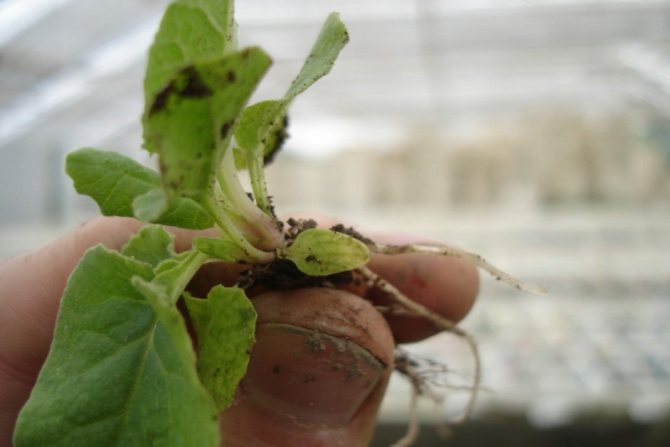

Picking up seedlings of primrose grown from seeds. <>
Landing rules
For landing, the following rules must be observed:
- there should not be a large amount of mineral salts in the ground;
- flowers should be well lit;
- the temperature where the flowers are located should be low;
- dried leaves must be removed immediately so that the flower blooms well;
- the transplant is carried out only after flowering;
- drainage is required at the bottom of the pot.
Seeds are planted from November to December. Primrose seeds will give good germination if, before planting them, keep them in high humidity at a temperature of 20 degrees. Further, the temperature and humidity gradually decrease. The dive is carried out twice: in March and April.
Frosty stratification, or the classic primrose sowing method
If you want to use the classic and most reliable method, then sow only on dry soil and on the surface. The seeds from above cannot be covered with even a thin layer of sand or sifted substrate: they only need to be pressed into the ground, but not too hard, but only by fixing them. Sometimes sowing in the snow is recommended, it can simplify the process itself, and help the seeds to "get sucked in".
The optimal planting density for primrose can be a critical parameter, misses in density are immediately felt at the stage of growing young seedlings. Primrose seeds are not laid out very thickly, so that no more than 5 seeds fall on 1 square centimeter of soil. Despite their small size, it is better not to mix primrose seeds with sand and lay them out by hand, using a toothpick or tweezers.
After sowing, do not spray the seeds from above. The containers just need to be covered with foil or glass. But do not rush to carry the containers to the windowsill: the primrose germination strategy is special.
Containers of sown primrose seeds covered with foil or glass should be sent for stratification.It is considered optimal to be kept in temperatures from -5 to -10 degrees for at least 10 (and ideally 20-30) days. A freezer is quite suitable for primrose, but you can simply put the containers outside (if the weather is frosty, watching the thaws), dig in a snowdrift or garden.
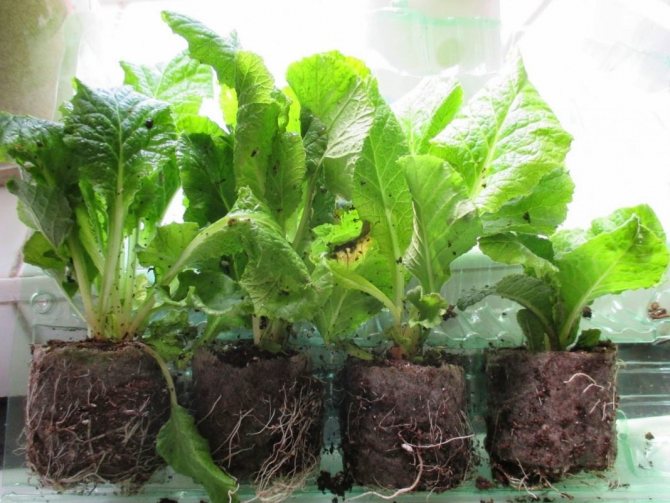

Seedlings of primrose grown from seeds.
Terry flowers agrotechnics
In the matter of agricultural technology, garden primrose does not differ from other double flowers.
The important aspects to look out for are the following:
- A shaded area is ideal for planting.
- The soil should be light and well fertilized.
- The soil can be slightly acidic, well loosened.
- The flower prefers organic fertilizers.
- The plant does not tolerate drought.
- It easily takes root after transplantation.
- It is necessary to periodically divide the flower.
Terry species are adapted to adverse weather conditions and safely endure winterwithout needing additional shelter. However, waterlogged soil in the cold season leads to the most negative consequences for terry primroses, so it is worth filling the circle around the trunk with a mixture of nutrients or dry leaves.
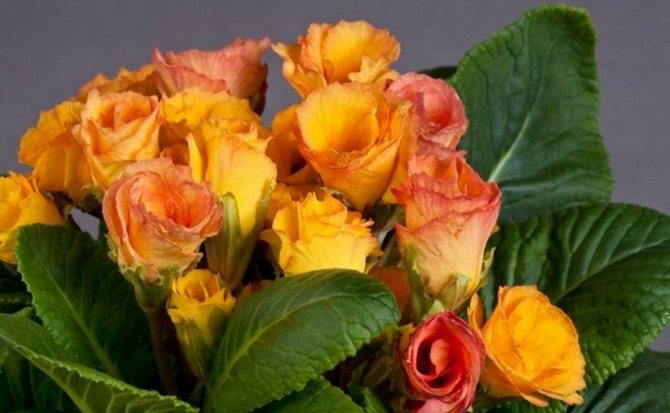

If the climate in the region is too harsh, you can cover the bushes with a film, or in general, by transplanting them into containers, place them for the winter in a warm place. Terry flowers are perennial, but they should not be left in one place for more than a year or two. In order for the bush to live longer, and the flowering to be abundant and bright, it is necessary to rejuvenate the plant by division and frequent transplantation.
Cold stratification, or a simplified primrose sowing method
Today, instead of freezing, a method of simpler stratification is also used - at low, but positive temperatures. The growing process is faster, but the likelihood of success is lower with this method.
There are two planting strategies that can be used for primrose without freezing temperatures:
- With preliminary "swelling" of seeds outside the soil;
- Direct sowing into the ground with exposure first to warm and then to cold conditions.
Pre-soaking primrose seeds is best done on a foam sponge cut into two parts (or with deep cuts in which you can put the seeds). The sponge is well moistened, the seeds are laid out on the surface, and then cover them on top with the second half of the sponge.
Having placed such an "oasis" in a plastic bag or container, it is better to put it in the refrigerator for a week, at a temperature of 2 to 5 degrees Celsius, and monitor the maintenance of constant humidity of the sponge. After a week or less, the primrose seeds will swell and can be sown into the substrate as usual. But you can use other strategies as well:
- soak primrose seeds in warm water or a weak solution of potassium permanganate for a day, and then place them in the refrigerator before "pecking";
- spread the primrose seeds on a damp cloth and place them under plastic wrap in a warm place for 2-3 days, then refrigerate until the first signs of germination appear.
Swollen or primrose seeds that have begun to hatch are spread over the surface of a moistened substrate with a toothpick, moistening the tip in water and gently prying the seeds. There is no need to press them into the soil, but the crops should be covered with glass or foil as soon as possible.
If you do not want to pre-soak, then sow primrose seeds directly into the soil, let them swell in it, and then place the containers in cold conditions. The seeds are simply laid out on the surface of a well-moistened substrate and immediately covered with glass or film. For 4 or 5 days, the containers are placed in the warmest place in order for the seeds to swell (you do not need to wait for the sprouts to appear, this stage must take place in the refrigerator).
The dish is transferred to the refrigerator and left in cold conditions until the sprouts begin to awaken and the first shoots appear.The containers with primrose are transferred to standard conditions for full germination.
There is also an alternative strategy: put containers with crops in the refrigerator (or take them outside) only at night, and keep them warm during the day. Shock changes can speed up the process of seed germination, but this strategy does not always work.
Sowing primroses of hybrid varieties: fine-toothed and ordinary
For primroses that do not need freezing and cooling of seeds, sowing is carried out according to the same principles as when freezing, but sown on wet soil. Further, the cooling stage is simply skipped and the plants are immediately transferred to conditions for germination.


Seedlings of primrose. <>
Reproduction methods
Seed germination after harvesting may drop... Winter storage at room temperature will reduce the chance of germination by 60%. If you store them for less than a month, the seeds will be divided according to the germination energy, and this will lead to large expenses. That is why it is worth sowing them in the ground after harvesting.
In February, sowing is carried out in a heated greenhouse. All varieties of primroses grow well on a substrate of rotted litter, sand and turf. Seeds must be sown over the surface at a distance of 1 cm from each other. During germination, the temperature should be 17 degrees.
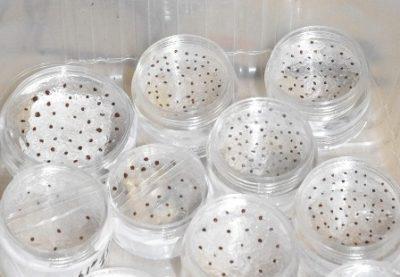

If sowing is done in the fall, then the seeds will begin to grow in the 4th month. Primrose and primrose seeds can grow in daylight, and primroses in complete darkness.
Diving of seedlings is carried out in the phase of appearance of leaves... If the weather conditions are right, seeding can be done immediately. Planting is planned very carefully - you need to leave space between the rosettes of leaves.
Seedlings germinate at the onset of the growing season. They are covered with leaves for the winter. We wrote about how to prepare a primrose for winter here, and from this article you will learn how to care for a plant in the fall.
Important! Primrose bloom is expected in the third year of life. In harsh winters, young bushes freeze out or grow out. To keep them, you need to renew your insurance fund every week.
For more information on how to breed primrose and other features of growing a flower, read this article.
Conditions for germination of primrose seeds
Without exception, all primroses, both stratified and not, must be provided with the same temperature for germination - from 16 to 18 degrees. But not all primroses will need lighting:
- containers are exposed in the brightest place for hybrids, primrose, Japanese, pink, Florinda, pubescent (be sure to install scattering screens so that direct sunlight does not fall on the seeds);
- containers are placed in the shade, with full shade or covered with black film for Siebold primrose, fine-toothed primrose and tall primrose.
You can accelerate seed germination if you cover the seeds with a thin layer of snow for the first few days, but you should not count on the emergence of seedlings earlier than in two or three weeks. The later the sowing, the longer the seeds germinate. An important condition for germination in this phase is the maintenance of light and stable moisture. Drying out of the substrate is almost guaranteed to lead to a complete loss of crops. However, waterlogging is no less dangerous for primrose.
Before germination, all primroses need daily ventilation, film or glass removal. From the moment when the first shoots appear (for those who underwent non-frost stratification - the first false leaves), primroses must be slowly adapted to an open container, accustomed to the air, opening the film or glass at first for 30 minutes, but increasing the airing time every day.
It will be possible to completely remove the film or glass only after 10-12 days. By this time, the seedlings should be strong enough to survive in non-greenhouse conditions.There is no need to be afraid that primroses will simply "bury" in a shelter: seedlings develop so slowly that they are more likely to die from a violation of moisture, and not from contact with the film. Their rapid growth and development begins later.
Lighting for all primroses after the emergence of friendly seedlings should be bright, but diffused. Young plants cannot stand direct sunlight.
Pests and possible diseases
Primrose is a hardy plant, but it can also be affected by diseases. Among the most common are the following:
- Powdery mildew... Yellow or brown spots appear on the top of the leaves. It resembles the spores of a fungus. The development of the disease occurs at high humidity and moderate temperatures. The infection persists in the affected areas.
- Gray rot... Affected areas are flowers, peduncles or leaves. They can be covered with a fluffy coating. The disease makes itself felt in cold weather. The infection can be spread by rainwater or ants.
Growing seedlings of primrose
The slow development of primrose seedlings is the main reason that the diving of plants is carried out quite early: seedlings in a common container grow only until the first full-fledged leaf appears (in the strongest first shoots, by the time the first leaf is released, the rest can develop the second). Until that time, the main task is accurate watering.
Plants are sprayed from a finely dispersed spray bottle, evenly moistening the soil and trying not to soak the sprouts too much. The substrate, as in the germination stage, must be constantly moist, but not damp. Drying out of the soil is destructive.


Seedlings of primrose.
Care after landing
Plants are picked when two leaves appear.... After a few days, the seedlings are accustomed to the open air. They need to be taken out to the balcony and the polyethylene removed. Watering is carried out very carefully - you can use a pipette for this.
Attention! Planting seedlings in the prepared soil is carried out after the frosts have passed.
Now you know all about boarding and grooming.
You can get even more information on the intricacies of primrose care here.
Primrose seedlings dive
Primroses are usually grown with two picks. The first is carried out at the stage of one or two true leaves, transferring the plants as carefully as possible, avoiding contact with the roots, into individual cells or large containers with a distance of 5-6 cm between plants. Plants need the same care, with careful watering. After the first pick, primroses begin to grow actively.
The process of growing seedlings of primroses is often so delayed that by the time of the second dive, the threat of severe frost at night has completely disappeared and the plants can be transferred to open soil without diving. It is possible to plant such primroses in a permanent place, but it is better to plant them in a separate bed or flower garden for growing, and transfer them to the second year in the composition.
If the weather is not yet suitable for planting in the garden, then young primroses dive into large containers or seedling boxes, keeping a distance of about 15 cm to honey with bushes. If necessary, the pick can be repeated a third time (if the plants are developing too actively, grow densely, then it is better to transfer them from the boxes to separate containers).
History of appearance
The primrose has been known for many hundreds of years. In ancient Greece, it was called the medicinal flower of Olympus. Also, the people called it "keys" or "rams". According to the myths of ancient Scandinavia, the flowers of this plant are the keys of the fertility goddess Freya. Thanks to them, she lets spring in. In Germany, these flowers are believed to be the keys to getting married. Among the Celts and Gauls, primrose was present in love potions.
Scheffler reproduction: interesting methods and examples of planting
According to the stories of Denmark, an elf princess turned into this flower because she fell in love with an ordinary person.
Ancient Greek myths tell that a young man named Paralysos died of love. He was turned into primroses by the gods. The gods were very sorry for his death.
Important! This plant can heal many diseases, including paralysis, for which in folk medicine it is even called a paralytic herb.
In European countries, this flower has been cultivated since the 16th century. The British have a special affection for him, who even created a club for primrose lovers. Every year there are exhibitions of primroses.
Flower characteristic
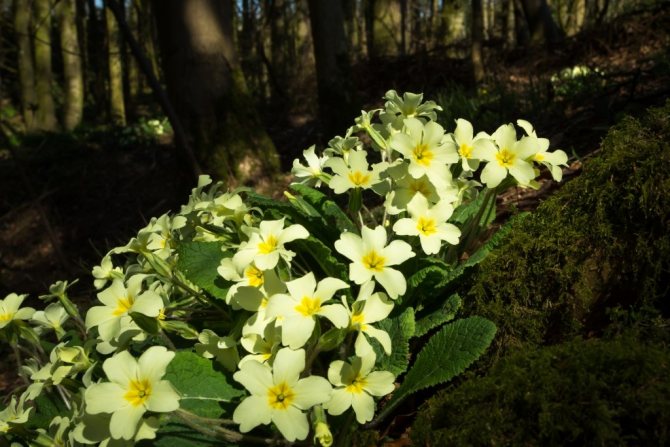

The natural habitat for the flower is the shady forests of Eurasia and North America. The view can be found on the slopes of the Alps and on the Mediterranean coast. The plant prefers moist and shady places. It begins to bloom in early spring and pleases with colors until mid-summer. During this period, the flowers have time to renew their petals several times (every 3–8 weeks).
It is a perennial (sometimes annual) plant that does not exceed 30–50 cm. The peduncle is decorated with a dense umbrella with corollas of five or more petals of a wide variety of colors with sharp or rounded tips. The diameter is 6–8 cm. The core is predominantly yellow. Leaves are sessile or petioled, oval or oblong in shape. They have solid or finely toothed edges, covered with small, soft villi and well-defined veins.
What is this flower?
This is a perennial plant that, as soon as the snow melts and the earth warms up with the first rays of the sun, it begins to sprout from the ground. When the primrose is in full bloom, it covers the ground with a green veil, soft as a pillow and beautiful as a landscape in an artist's painting. She is completely unpretentious in care. There is no need to specifically buy fertilizers - you can use any that are at hand.
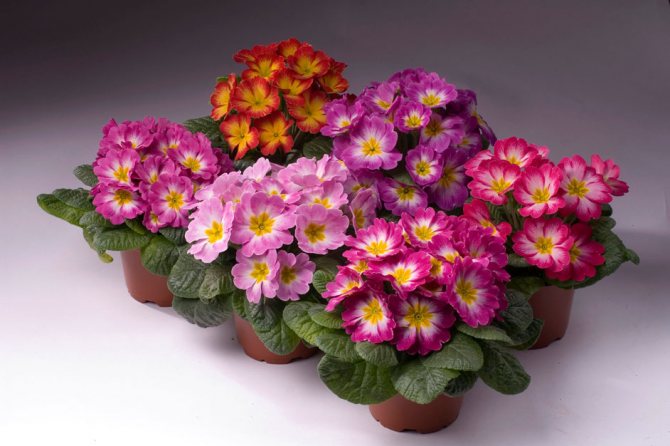

Primula stemless is distinguished by abundant flowering and varied color of flowers.
For a long time, these plants have been grown in front gardens, gardens, even in personal plots. The primrose grows short, its leaves are bright green. They are placed on short stems and taper at the tip. The flowers are also short, of different colors. The most famous are white, pink and yellow. True, in the markets in small pots you can see hybrids of common primrose of various colors, even with eyes. They are so bright and colorful that they will decorate the most ordinary windowsills.
Primula stemless is the most wonderful gift. It can be presented to girls and women on Valentine's Day, on March 8, on their birthday. Even men will be happy with such a flower, because it will not wither on the second day, like ordinary tulips or roses that are sold in bouquets. This plant will delight with large and beautiful lush buds for about 2-3 weeks. This is the average flowering time. But if you put the pot in a cool place (+18 - +20 degrees), the plant will bloom much longer.
The price is also worth mentioning. A flower pot is quite inexpensive, much cheaper than a bouquet.
Plant care
- Primrose bushes should be planted in partial shade.
- Choose a fertile, light soil. Before planting flowers, it is better to fertilize the flower bed. Many growers have noticed: the richer the soil in the flower bed, the brighter the primroses flowers.
- Top dressing. In the fall, the soil can be dug up with humus. If you haven't, water the flowers with an organic fertilizer solution in the spring. The second feeding is carried out at the end of summer (it is she who stimulates the plant to re-flowering). Here you can already use purchased mineral fertilizer (for example, "Kemiru").
- The primrose will not survive drought, so be prepared to water it frequently. Most of all, terry primrose is watered from May to June. From July to August, the faded plant falls into a dormant period, it also needs moisture, but less. Well, from the end of August, if your bushes start to be active again, resume frequent watering again.
- From time to time, transplant the bushes to other flower beds, and separate the largest ones. For most varieties, replanting every 3-4 years is suitable.
- When planting adult primroses, make sure that the leaves of the bushes touch each other (close). This will allow the soil of the flower bed to store moisture better without drying out until the next watering.
- Most of our varieties winter well without shelter. True, if in the fall you cover the ground in which the primrose root is hiding with fallen leaves or nutritious soil, the plant will only be grateful to you.
Moisture combined with cold can kill the plant.
In more detail about why garden primroses die and how to save them, an experienced florist will tell in this video:
In landscape design
Garden primrose, thanks to a wide variety of colors, allows you to create an amazing ornament on the site. Since flowering varies greatly in terms, you can pick up varieties that, replacing each other, will delight from April to August. Flowers are used to decorate a rabatka, an alpine slide, flower beds in the shade of trees, edging a curb, shrubs, a high bank of a reservoir. They look good next to muscari, tulips, daffodils, irises, phlox, soapwort. Some species with inflorescences on long stems are cut to form bouquets.
Asian primroses in full bloom will surely delight the heart in late spring at first glance. Primula bulleyana, P. beesiana, P. japonica, P. pulverulenta; these are all plants of great beauty and color. The genus Primula includes over 450 species. Among the most beautiful and brightest are Primula denticulata, (fine-toothed primrose) easily growing, originating from the meadows and light forests of the Himalayas. Primrose of this variety grows most in gardens. It is suitable for any garden where the soil is neutral or acidic and does not dry out in summer. Small-toothed primrose has distinctive large spherical heads, consisting of many neat bell-shaped densely packed golden flowers, at a height of 25-30 cm.The flowers are pink, lilac or red, and the leaves are finely toothed, slightly hairy and deciduous, fall off in autumn. Flower buds begin to appear in the center of the expanding new leaves. These buds open before the flower stems begin to elongate. The stems elongate over several weeks, carrying flower clusters to the top. Its spoon-shaped leaves are silvery green and mealy. Leaves initially begin to expand as soon as they appear.
In nurseries and garden centers, you can find a plant simply called Primula denticulata, but there are many named garden forms that have translucent reddish purple and white flowers. There are also other species. Hybrid varieties not only come in an array of flowers, they can have single or double flowers. Primula vulgaris and Primula vulgaris sibthorpii receive the Royal Horticultural Society's Garden Achievement Award! A truly worthy reward for a worthy plant. The fine-toothed primrose is unique in appearance and can be grown in a large, showy group. She is also good at home. It can be grown under tall, deciduous shrubs or near curbs, but will also look good when sown in a swamp garden near water. The best companions include the spring snowflake, Leucojum aestivum, tree anemone, Anemone nemerosa, and the purple-pink canine tooth, Erythronium revolutum.
Primula stemless: grown from seed.
It is very easy to grow primroses from seeds. If you want to break a delicate pink-cream carpet under the old apple trees, collect the seeds of your primroses - they sprout very amicably, and will not cost you a dime.
Plants from seeds collected in their garden do not retain varietal characteristics, but this is how you can get new colors of primroses. Before sowing, store the seed capsules of primroses at a temperature not higher than + 5 ... + 7 ° С.
Gently shake out the seeds from the dried seed fruits over a saucer:
Before sowing, pickle the primrose seeds collected in the garden to protect the seedlings from fungi (you do not need to process purchased seeds, it is enough to steam the soil). To do this, prepare a 0.5-1.0% solution of potassium permanganate:
Place the primrose seeds in the prepared potassium permanganate solution for 20 minutes:
Spread clean snow over the soil in a container:
Spread the seeds over the snow - so they evenly and without covering will end up on the soil surface:
After sowing, snow must be compacted:
Label the types and varieties of primrose plants sown with tablets:
After sowing, cover the container with a lid and secure it, for example, with an elastic band:
Fresh primrose seeds usually sprout after a short cooling; they are tough in primroses. There is no need to be afraid of this procedure - the mechanism is laid down in nature, where they lie under the snow all winter and germinate in early spring. The container with crops should be kept in the refrigerator or under the snow for 2-4 weeks. In our case, the container with the seeds was buried in a snowdrift outside. Another option is to place the container in a plastic bag and place it on the shelf in the refrigerator.
Crops that have undergone stratification can be displayed on a bright window, shading from direct sunlight. The optimum temperature for the development of seedlings is + 16 ... + 18 ° С. When two true leaves appear, the seedlings dive. To get started, carefully pry off the large nests, without injuring the roots, and put them on a saucer:
Divide the primrose seedlings one at a time, plant in a box in 5 cm increments or in individual pots:
Pour the cut primrose seedlings with a thin stream of water. In the future, they need to be regularly watered and fed.
The grown primrose seedlings in June, after the end of the threat of frost, can be dug in the same container until the end of summer in a semi-shady part of the garden. It is better to plant the plants in a permanent place in the second half of August, when cool and rainy weather sets in, at a distance of 25-30 cm from each other.
Illustrations to the material: shutterstock
It is not for nothing that primroses are called primroses - in the spring they bloom before anyone else. And from Latin ...
It is not for nothing that primroses are called primroses - in the spring they bloom before anyone else. And from Latin ...
Resistant varieties of stemless primrose - durable plants, plastic and tolerant to ...
There is still snow, and in the garden centers there are already shelves with the brightest flowers. Who just named this ...
The gardener's dream is for the plants to grow by themselves, do not require care, reproduce themselves, ...
Flowering plants bought in the middle of winter in flower shops are advised to be treated like ...
Already in the 16th century, in the works of botanists, hybrids were mentioned between two Alpine primroses: ear and ...
The popularity of rare Japanese plants and interest in them are growing from year to year. All for what ...
Primroses are often considered unpretentious plants, which are enough to plant in moist peaty ...
Most primroses bloom in spring. Each has its own merits.
Primroses need to be divided frequently. Usually this operation is started two weeks after the end ...
The popularity of rare Japanese plants and interest in them are growing from year to year. All for what ...
The common primrose, or stemless, has beautiful terry varieties. But not all of them lead reliably ...
Features of the species and popular varieties
There are many varieties of fine-toothed primrose, but we will note the most common of them in our gardens. All of them have small flowers, collected in large heads on high peduncle stems, and a wide rosette of pubescent leaves, oblong with serrations, which are very decorative in themselves.
Alba
Many plant species have varieties called "Alba". This was not without it in our case.Small flowers of this variety, up to 1.5 centimeters in diameter, are collected in ten-centimeter round dense white caps on peduncles from twenty, at the beginning of flowering, up to fifty centimeters high. The variety is frost-hardy, prefers partial shade and moist soil.
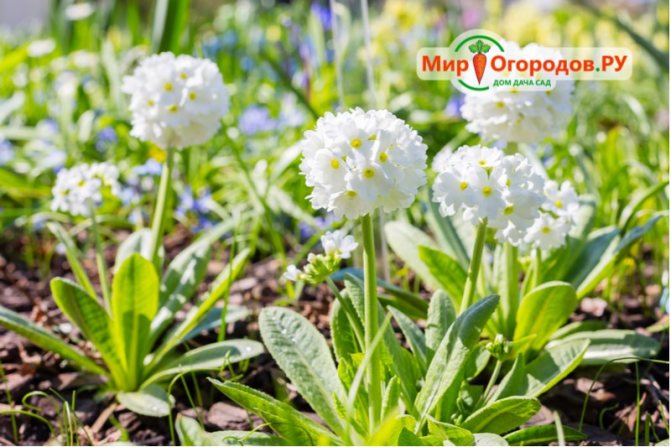

Alba fine-toothed primrose
Violet
As you might guess from the name, the primrose flowers of this variety are purple in color. The balls are slightly less large and dense than those of Alba, and are located on stems up to twenty-five centimeters high.
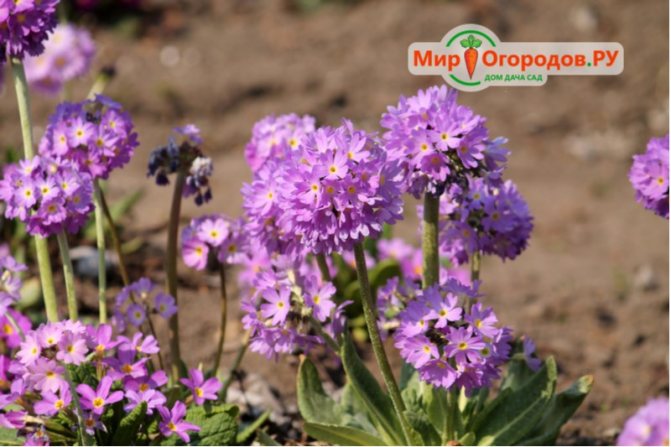

Purple primrose hats Violet
Rubra
Rubra fine-toothed primrose variety of bright red, ruby hue. He is similar in height and shape to the above Violet. Winter hardiness, application and flowering time, like other primroses.


Rubra variety - dark ruby charm
Primrose - planting and care: reviews and advice from professionals
Priula is the primam of the spring garden
This modest and unpretentious, but incredibly bright flower not only enjoys the love of gardeners, but also has a special history.
Legend has it that one day the Apostle Peter fell asleep and dropped the keys to Paradise. And hitting the ground, they sprouted up with cheerful primroses.
Primrose, or primrose, is the favorite of most gardeners, and almost anywhere in the world. At one time, England was even swept by primomania, a "disease" so similar to the Dutch "tulip mania". Why is this little girl so good?
Perhaps the beauty's main talent is the ability to be different: in nature, there are from 400 to 550 species of the Primula genus! But this is far from the limit, since botanists continually discover new ones, and breeders do not get tired of creating hybrids and new varieties. As a result, today the primrose is able to satisfy any whim: not only do its flowers amaze with all kinds of colors - even gray and green, two- and three-color, with or without a pattern.
Primroses also differ in the structure of inflorescences. On this basis, they were divided into 5 groups: cushion-shaped (for example, common primrose), umbrella-shaped (such as high primrose or spring primrose), spherical (for example, fine-toothed primrose), candelabra (one of them is bullsian primrose) and bell-shaped (primrose Florinda). By the way, not all of them bloom in spring.
There are many species that adorn the garden in summer, such as the primroses of Biss, Florinda, Bulley. You can rest assured that even if you decorate a flower garden exclusively with primroses of different types and varieties, it will be incomparable. But the bright "prima" is quite "sociable" - it goes well with other spring-flowering plants, as well as with low-growing ornamental grasses and ferns.
The main condition for the prosperity of our many-sided heroine is an abundance of moisture in the soil in spring, but without excess and even less stagnation. The ideal place for a plant is partial shade with well-drained fertile soil.
If the primrose lives in a pot, make sure that the substrate does not dry out (only common primrose more or less calmly tolerates drought in summer). Top dressing is done 3 times per season: in early spring, 2-3 weeks after the first, and at the end of July or mid-August. For the winter, it is advisable to sprinkle primroses with dry leaves with a layer of about 10 cm, since even the most hardy in the absence of snow can freeze.
Primula photos and species


- Primrose high it reproduces well by self-seeding and grows rapidly, but only on condition that the soil is fresh, moderately moist and rich in humus.
- Japanese primrose Miller's Crimson blooms in June - July. She prefers partial shade and moist soil. The purple-red flowers of this varietal plant attract attention with their unusual dark centers.
- The spring primrose (Primula veris) has small bright yellow flowers. Their distinctive feature is orange spots at the base of the petals.
- In a bast basket, they look organic common white primrose and spring primrose... By the way, such an ensemble can be an excellent present for a gardener friend.
ORDER QUALITY AND CHEAP SEEDS AND OTHER PRODUCTS FOR HOME AND COTTAGE. PRICES ARE BOTTLE. CHECKED! JUST LOOK FOR YOURSELF AND BE AMAZED HOW WE HAVE REVIEWS. GO >>>
Below are other entries on the topic "Cottage and garden - do it yourself"
- Primrose - planting and useful properties: Plant primrose - for beauty ...
- Primrose from seeds: How to grow primrose from seeds Primrose ...
- Japanese primrose planting and care: Growing Japanese primrose Japanese primrose, in ...
- Renewal (rejuvenation) of a primrose - how is it correct ?: How to renew a primrose I renew primroses by dividing ...
- Primrose care - primrose: How to care for primrose primrose There are several ...
- Primula auricula (auricular) - planting and care, reproduction: Auricular primrose (auricula) - growing, ...
- Auricula flower types and care: AURICULES: LITTLE ENGLISH MADNESS Auricula primroses, ...
Subscribe to updates in our groups and share.
Selection and preparation of containers
With the choice of the landing capacity, everything is now very convenient and simple. In any store specializing in goods for the dacha and for the garden, or in an ordinary hypermarket, you can buy a variety of containers for planting. And you can also use improvised means, for example, various bowls, cut plastic bottles, etc.
It is very convenient to plant primrose seeds in the following containers:
- plastic box:
- wooden box;
- plastic cassettes;
- peat pots;
- plastic cups;
- peat tablets.
Since the seedlings of a flower culture need a pick, then it is very convenient to initially sow seeds in a common plastic or wooden box, and then plant them... But when grown in peat tablets, you do not need to dive seedlings.
Important! There must be drainage holes at the bottom of the landing container. If you did not find them when buying, then you need to make holes yourself. The exception is peat tablets and pots, you do not need to make holes in them!
Before planting seeds, it is recommended to disinfect containers (except for peat tablets). Just rinse the container with potassium permanganate solution or fungicide solution.
Everything you need to know about the features of a flower
A perennial flower culture called Primula has an interesting bush shape and a rather miniature rosette size. Believe it or not, about one and a half thousand varieties of this plant are known, and they all have distinctive features: color, shape, flowering time.
Among the main advantages is the amazing adaptability of the primrose. It can grow successfully on a wide variety of soils and endure the most unexpected climatic surprises in the form of a sudden cold snap or even snow.
It reacts incredibly calmly to drought, the only thing is that its flowering ends quickly when there is a lack of moisture in the soil.
There are a great many options for using it in landscape design: these are flower beds, and rock gardens, and borders and flowerpots.
Among the species, the ear primrose is especially popular and loved by gardeners, a very beautiful and compact plant no more than 15 cm high. This variety has more than twenty varieties and can be easily grown from seeds.
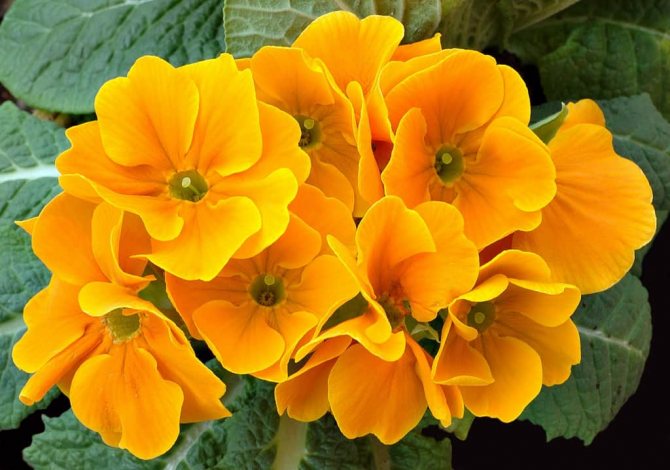

Pros and cons of terry hybrids
Terry for primroses is an acquired characteristic, multi-petal primroses do not occur in nature. This direction of selection is especially developed in relation to three species - P. stemless, P. auricula and P. polyantova. Terry primroses are most often sold in flower shops with seeds and ready-made plants, it is they who amaze with the large size of the flower, deep and unusual shades.
This group of primroses has both advantages and disadvantages. Let's talk about the pros first.
- Terry varieties have increased decorative effect. Multi-petal roses reach a diameter of 4–5 cm, and a cap of flowers - 10–15 cm.The size of the plant itself is compact, leveled, foliage retains an attractive appearance after flowering (especially in auricles).
- The flowering period for most hybrids is 2-3 months - it begins in April, lasts all May, captures June. With intensive care, many varieties tend to re-bloom in September - October, this is a real find for a late autumn garden.
- They can be grown not only in the garden, but also indoors. After the autumn transfer to the pot, they bloom in February - March.
- They lend themselves well to early spring distillation from seeds, bloom in the first year of the growing season.
But there are also disadvantages to terry primroses.
- They require more careful maintenance, and in order to reach their full potential - fertile soil and regular watering.
- Winter hardiness varies in the range of -23–25⁰ С, which is lower in comparison with ordinary spring primroses. It is advisable to cover high-quality plantings for the winter or transfer them into a container.
- Although the primroses are perennials according to the cultivation technology, they are rather youngsters, requiring frequent transplantation and rejuvenation of the bush. Some hybrids, such as Primlet F1, were originally bred as biennials.
- Terry varieties will not give seeds, so they can only be propagated vegetatively.
It is interesting! The UK is famous for its floral traditions. On April 19, the country celebrates Primrose Day, thus paying tribute to the prominent statesman Lord B. Disraeli, a great connoisseur and collector of these garden flowers. An indispensable attribute of the holiday is an exhibition of primroses.
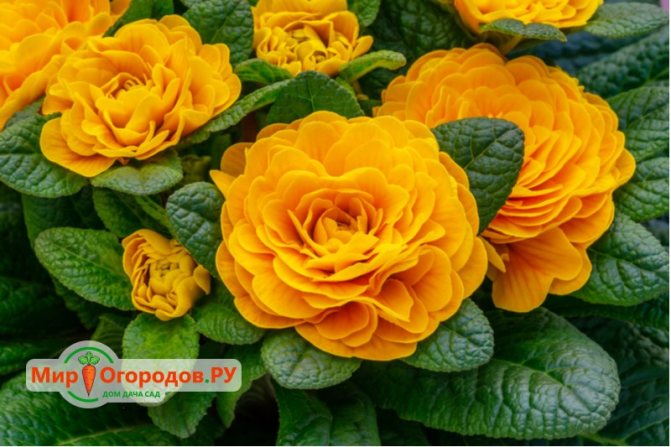

Primrose from the Ballerina series
Primrose, in which there is nothing ordinary
The south and central part of Europe is the natural area of growth of stemless primrose (P. common), but due to its high plasticity and quick adaptation to climatic conditions, cultivation in more northern regions is not difficult.
Perennial herbaceous culture is a dense compact bush, consisting of a thick short rhizome and a rosette of elongated lanceolate leaves of a dark green color, with a convex, wrinkled texture. In early spring (at the turn of March and April), a bouquet of simple 5-petal flowers blooms over the rosette. Each corolla rises on a separate peduncle, they are not collected on a common stem in an inflorescence, hence the name "stemless". Natural color is yellow, sometimes white with a purple eye, flowering usually lasts 3-4 weeks. The seeds ripen in June, and September is the time for the plant to re-bloom.
The description of stemless primrose in the reference literature and by a tenth does not convey the delightful, delicate beauty of the flower that you see in reality. This is especially true of modern varieties and hybrids, which are characterized not only by abundant flowering, but also by the most unusual color - pink, blue, apricot, scarlet-red.
Advice! When planting bright primroses in a flower bed, avoid the cacophony of colors. Nearby, overgrown clumps of one or two varieties look much more interesting and elegant. For borders, it is better to use species that preserve green foliage in summer (stemless primrose, ear primrose).
Application in landscape
From primroses, dense borders and colorful rugs are obtained. The array can be located both near the track, and at some distance from it. For one group, it is worth using primroses of the same color. This is easy to do if you divide one overgrown clump.
Primroses are easy to combine with tall perennials that will cover them from the scorching sun in summer - peonies, phlox or even roses. Ferns, even large ones, just planted at the proper distance, hosts, cereals, mountain weevils, hellebores - almost the entire shady assortment - are quite compatible with them. Small-bulbous are very good in joint plantings.
Popular variety series of terry primroses
Despite the abundance of varieties, in the middle lane, several variety series have taken root and show good vitality - groups represented by identical plants, but with different colors of flowers.
- The most popular terry primrose is Roseanne F1. It forms dense compact bushes up to 15 cm high, topped with a cap of multi-petal flowers. The series includes 5 colors - red, pink, yellow, apricot and white. A real perennial, grows quickly, loves partial shade, moist and nutritious soil.
- American hydride P. stemless Primlet F1 is exotic beautiful and unusual, but more difficult to grow in garden conditions. It was bred as a biennial; without a radical renewal of the bush, it quickly loses its decorative effect. They like to use it for forcing, as it is a very early plant and blooms in the first year of the growing season.
- Unlike Primlet, the double primrose of the Paloma F1 series can grow in one place for up to 7 years. Seeds are planted before winter or early spring, blooms in the second year, duration - up to 50 days. The stores sell mixes of different colors.
- The variety series of primrose terry Rosy is a novelty of selection, it is distinguished by early, long flowering, splendor of the flower, versatility. It is equally good in an open flower bed, in a pot, in a street container.
Note! P. ear or auricula has many double varieties - Jupp, Xaver, Max, Suzanne, Crimson Glow. It is generally accepted that these are capricious plants, but multi-petal auricles are much better adapted to open ground and cold climates than “ocellous” show specimens covered with a mealy bloom.
Watering and moisture
The watering requirements for indoor primrose are similar to those for plants grown outdoors. The land in which the flower is grown must be moist and loose. It is important to especially carefully monitor the state of the soil during flowering. Excess or lack of water is bad for the duration of such a process. When the flowering ends, the amount of watering should be reduced. Do not allow the soil to dry out excessively.
Water requirements for primrose irrigation are as follows
:
- It must be well-established.
- You can use melt water or rainwater. Some growers use this option and are satisfied with the result. It is important to bring the watering temperature to room temperature.
- You should not use tap liquid, and if there is no other way out, it is better to boil it.
- Watering with distilled water can be carried out.
Flowering occurs in early spring. It is important to create an optimal moisture level for the plant:
- Install a humidifier in the room. The grower will need to adhere to the regime and the humidity level will be at the required level.
- Maintain the moisture level in a simple way - place a saucer of water next to the plant or put a damp cloth over the battery.
- You can put the pot on a pallet, and place expanded clay, moss and sand in the container. You will only need to water the water periodically to maintain the desired humidity level.
How to grow primrose for the holidays
It is very pleasant to receive a flowering bush by March 8 or a birthday, and to drive it out and present it as a gift is doubly joyful. For accelerated development and flowering, we create the most favorable conditions for healthy adult primroses:
- In the fall, we dig out the flowers, transfer them to separate small containers.
- Store in a cool dark room with a temperature of about eight degrees.
- In order to get ready for March 8, at the end of January we transfer the plants to a lighter and warmer place. The temperature should not rise above 18 degrees. We begin to water the soil in pots little by little.
- In early spring, flowering begins. For the prevention of diseases, we spill a fungicide in a month, we feed them regularly.
- We rearrange the faded bush in a cool, bright place for rest and recovery.It will be possible to expel him again only after two or three years.
Primroses are unpretentious and grateful plants. Their value lies in their early, lush bloom, when the other inhabitants of the garden have not even grown foliage yet. Outside flowering will highlight any celebration. And in each case, the joy of contemplating this beauty more than rewards us for the efforts to painstakingly create it.
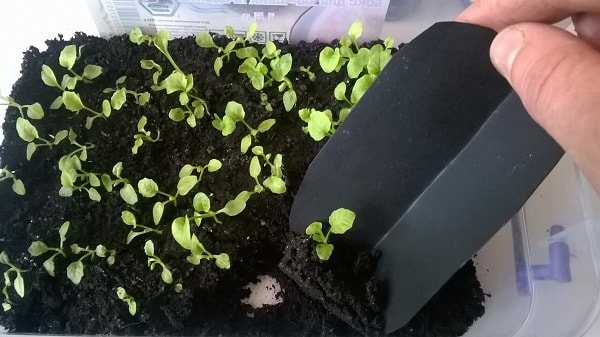

Landing in the ground
If you plant seeds in March, then by the spring there will be ready-made primroses seedlings and they can be planted right under the open sky. For them, a daily rate of 10 degrees is suitable. But before disembarking, you can leave them outside for several days in a container.
For primroses, an area where the sun's rays do not often fall is suitable. It is important that there is sufficient air circulation between the bushes. Therefore, the optimal distance between them is 20-30 cm.


Hybrid varieties of primroses can bloom in as little as 6 months. But other varieties can have color only in the second year.
Leaving the bush for the winter, you need to make sure that they are covered with tree leaves. For this, 10 cm of dry leaves are enough. Then the primroses can safely overwinter.
When will primrose bloom?
Seedling primrose from seeds is ready to lay buds already at the stage of 6-8 true leaves. For early varieties this occurs 16 weeks after sowing the seeds, for later varieties - 8-10 true leaves. For successful flowering at the stage of laying the buds for primrose, it is necessary to lower the temperature. At night, it should lie within 0 ... + 10 degrees, during the day - 2 degrees higher. Bright lighting without direct sunlight is required. The main thing here is not to overdo it with watering. At low temperatures, the primrose drinks very little water, and therefore there is a possibility of overflowing the flowers.
They keep the primrose at the budding stage in low temperatures for about 6 weeks until the buds appear. Then the temperature of keeping plants is increased to + 10 ... + 15 degrees at night and up to +18 in the daytime. Higher temperatures have a negative effect on flowering. You can make additional fertilizing, but half the concentration of the recommended one, since at low temperatures the plant's metabolism slows down.
Perennial flowers that can be planted by seeds, photo
For growing at home, the following types of primroses are suitable:
- malokoides;
- obkonik;
- akaulis, etc.






For growing primrose outdoors, the following types are suitable:
- fine-toothed;
- orchid, etc.
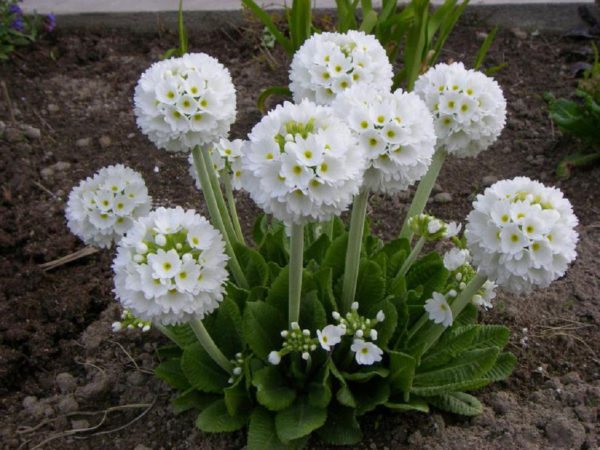



You can get acquainted with various types and varieties of primroses and study their photos here.
Step-by-step instructions for growing a primrose
Indoor conditions, the most often cultivated variety Obconica and several hybrids of garden primrose.
Some plant species, especially Obconica, cause allergic reactions. People with increased skin sensitivity should wear gloves before work, and it is advisable to place the plant away from children.
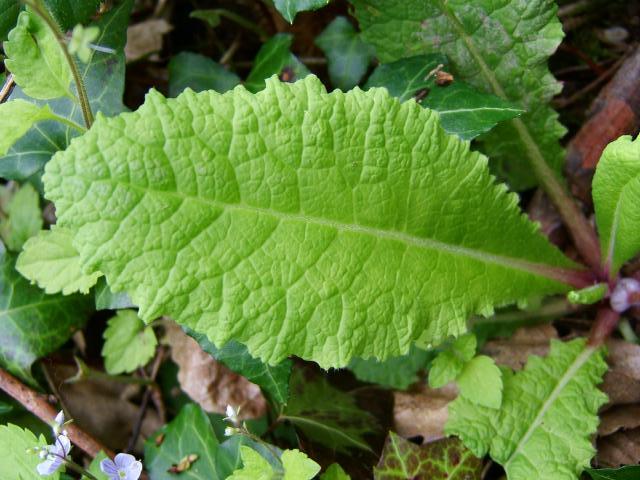

One wild primrose leaf replaces the human body's daily need for ascorbic acid
General growing tips
Before buying seeds, you need to familiarize yourself with the basic criteria for cultivating this delicate flower.
Table 1. Tips for growing
| Growing conditions | Characteristic |
| Substrate | Loose and rough in texture. A classic substrate or a homemade mixture of equal parts of sand and turf and 2 parts of sheet soil is suitable. It should be well aerated. It is desirable that the composition contains at least 30% of sand or perlite. The earth is not sifted, only leveled after filling the containers. Moisten slightly before sowing. Since primrose seeds are very small, they do not leave holes in the soil into which they can fall. |
| Containers | The following options are suitable for landing:
|
| Sowing time | In room conditions, seeds are planted in late January - early February. Later, it is not recommended, since the plants can bloom in the fall or next year. |
| Temperature regime | For seedlings germination, a temperature of 15 ° C is required. The first shoots appear 10-15 days after planting. A decrease in temperature by several degrees does not affect germination, but an increase delays development by 1 or 2 weeks. When the seedlings have risen, the optimal temperature regime is 20 ° C, for some species - 13 ° C. Flowering plants prefer coolness - 15 ° С. The high temperature will shorten the flowering period. |
| Lighting | Seed containers are placed under diffused light or in the dark. It is important to take into account the seasonality - in the warm season, protect from the scorching sun. Autumn and winter rays do not harm. There are both shade-tolerant species, such as the Japanese primrose, and light-loving ones - cascading and powdered. |


There are about 500 varieties with different inflorescence shapes and flowering periods.
Step 1. Collection and selection of seeds
There are several ways to grow primrose - by root cuttings, dividing a bush, rooting shoots or seeds. For growing at home, the latter method is preferable.
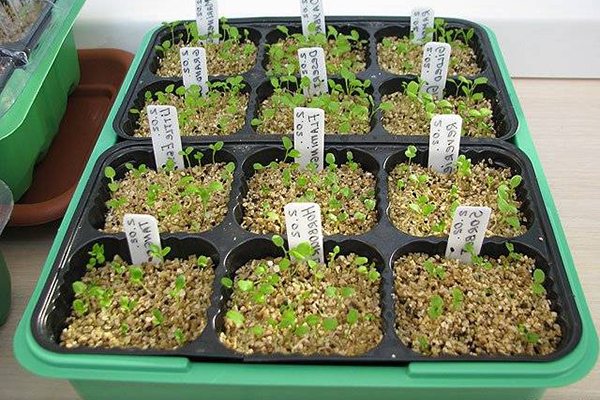

99% of the result is due to the quality of the seeds, not agricultural methods
Seedling boxes prices
seedling boxes
Self-collecting seeds
Primrose seeds are dark microscopic seeds in the shape of a sphere or cylinder. They ripen in August. Gardeners advise to germinate them immediately after harvest.
2 weeks after harvest, the seeds lose their germination by 40%. The duration of the seedling germination period also increases.
To prevent spillage, the seeds are collected from not fully opened bolls in which they are contained. Store seeds in a cool place. 20 ° C is considered a critical temperature, above which they begin to deteriorate.


The collected seeds love the coolness
Buying seeds
The flower shops offer a wide range of different varieties. When purchasing them, it should be borne in mind that not all flowers retain the qualities of the variety after germination. When choosing a particular species, special attention is paid to the duration and characteristics of the growing cycle, as well as the appearance of the plants.
Step 2. Determining the timing of sowing
For purchased seeds, the sowing period starts at the end of January and ends in February. If it is possible to apply artificial lighting, the seeds can be sown starting from the New Year. For harvested, the sowing time is the same as the harvest time. The sooner they fall into the ground, the better the chances of successful germination.
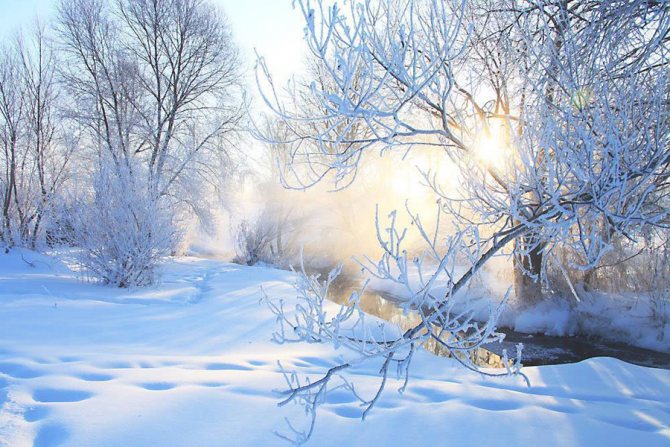

The optimal time for planting is February
Step 3. Pre-treatment of seeds
To accelerate germination, seeds are subjected to additional influences. The most popular is the stratification method. It makes it possible to simulate all the stages through which the seed passes during the germination process.
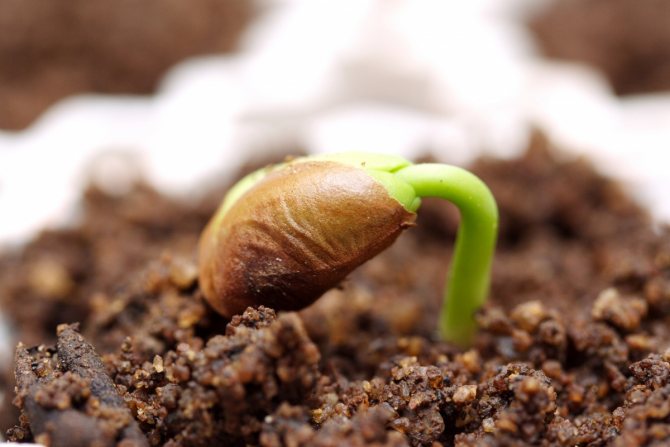

Stratification - artificial simulation of seed awakening processes
Stratification
Under natural conditions, the seeds fall on fallen leaves and remain under a layer of organic debris until spring. Conditions of stay - zero temperature, a humid environment and a sufficient amount of air. This contributes to the transformation of seeds and their preparation for further germination. Home conditions do not contribute to the rapid pecking of the grains, therefore, artificial methods of activation are used.
There is heat and cold stratification. The first method is used mainly for vegetable crops, the second - for indoor plants.
All varieties of primroses, with the exception of the common, fine-toothed and several hybrids, need this pre-treatment method. Several variants of cold stimulation are known, which are fundamentally different from each other by technology.


Fine-toothed primrose does not need stratification
Table 2. Varieties of cold stratification
| Method | Description |
| Classic | Within the framework of this method, a low temperature regime from -5 to -10 ° C is applied. Duration - from 10 days to 4 weeks. For these purposes, use a freezer, or put containers with plants outside in frosty weather. Before sending the seeds to cold conditions, it is necessary to familiarize yourself with the planting rules before stratification. The seeds are laid out in the upper layer of the substrate using tweezers, without pressing into the ground or mixing with sand. The location is free, for 1 cm 2 up to 5 seeds. Sometimes the ground is sprinkled with snow, in which primrose seeds are placed. The containers are covered with foil and sent for stratification. |
| Simplified | The phase of interruption of the physiological dormancy of seeds is characterized by the effect of low positive temperatures from 0 to 7 ° C. The technology is similar to the previous method. In this method, the germination process is accelerated, but the likelihood of success is reduced. |
If it is not possible to put containers with seeds in the refrigerator, the seeds should be sent to the freezer for 12 hours.


Common primrose can be grown without pretreatment
In order not to do unnecessary work, you should carefully study the instructions for planting indicated on the seed packaging. If they do not need stratification, this measure will not affect germination.
Soak
Feasibility of soaking seeds:
- Quality checking. Purchased kernels are often unsuitable for germination. If the seed has hatched, it is ready for development.
- Promoting germination. Pretreatment with water increases the seedling germination time.
- Disease prevention. This effect weakens pathogens. Soaking seeds in solutions that neutralize pathogens are actively used.
This method has a positive effect on the timing of seed germination, but is not an alternative to stratification. This generally applies to varieties for which the cold exposure method is not applied.


Seed Soaking Does Not Replace Stratification Method
General rules for humidification:
- a foam sponge well-soaked in water is used as a bedding,
- the seeds are placed on the surface and covered with another sponge;
- the structure is put in a plastic bag;
- stored for 7 days in a refrigerator at a temperature of 2 to 5 ° C.
Every day, the moisture content of the material is monitored and, if necessary, additionally moistened.


Potassium permanganate kills disease-causing bacteria found in seeds
There are branches from this method. The first is to soak for 20 minutes in a mild potassium permanganate solution. The subsequent steps are similar to the one already described. The second option is to lay out the seeds on a damp cloth under a film and store in a warm place for 3 days. Then the grains are sent to the refrigerator.
Prices for potassium permanganate
potassium permanganate
Alternative methods
If there is no desire or opportunity to engage in soaking, the seeds are sown into the substrate. When they swell, they are placed in containers, wrapped in foil and taken out into the cold. On day 5, the containers are placed in a warm place for the seeds to swell. Then they are sent back to the refrigerator and wait for the first shoots to appear. Then the primrose is placed in typical room conditions.
There is also a simpler technology. The seed containers are kept warm during the day and taken outside at night. Sharp temperature jumps accelerate germination in most cases.


Some gardeners begin to act on seeds after they are placed in the ground.
Step 4. Provide suitable conditions
It will take from 2 weeks to 20 days for the first shoots to appear. During this period, the seedlings should be properly cared for.
If, after 14 days, the first shoots have not sprouted, the containers are sent to the refrigerator for the same period of time.
Temperature regime
Regardless of whether stratification was applied or not, the best temperature for germination is considered to be from 16 to 18 ° C.
Lighting
Based on the characteristics of the variety, different light modes are used:
- Common primrose, Japanese and Florinda. Avoid exposure to direct sunlight. For this, scattering screens are installed near the plants.
- Primrose tall and Siebold. Placed in the shade.
Bright sunlight is contraindicated for any variety at the germination stage.
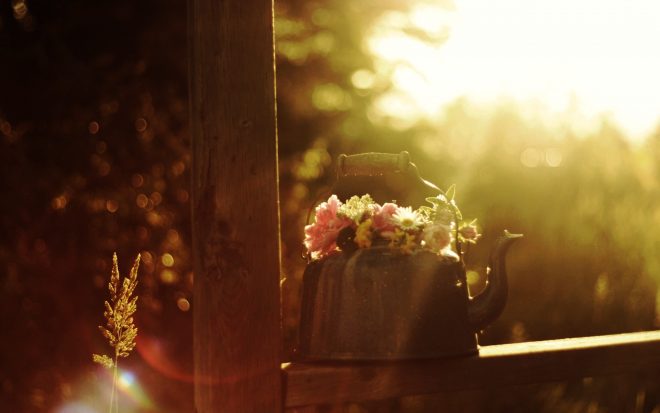

Direct sunlight negatively affects the growth of primrose
Humidity
The substrate should not be allowed to dry out. This is fraught with the complete destruction of crops. It is necessary to maintain a stable humidity, but avoid waterlogging.
Airing
Remove the film from the containers daily. This is a prerequisite for seed germination. Without this procedure, they may die. For the first sprouts, half an hour is enough to stay in the fresh air. Daily this period can be increased by 15 minutes. After 12 days, the film is no longer needed.
By this time, the germinated seeds are considered to be strong and ready for life in non-greenhouse conditions. At this stage, they grow very slowly and there is no need to be afraid that they will die from contact with the film. More terrible for them is the violation of the humidity regime.
Favorable periods for sowing
Sowing primrose from seed begins in February and ends as early as October.
- In the Moscow region, they begin to sow seeds in early March.
- In the Urals - from mid-March.
- In Siberia - from late March or early April.
- In the southern regions - at the end of winter.
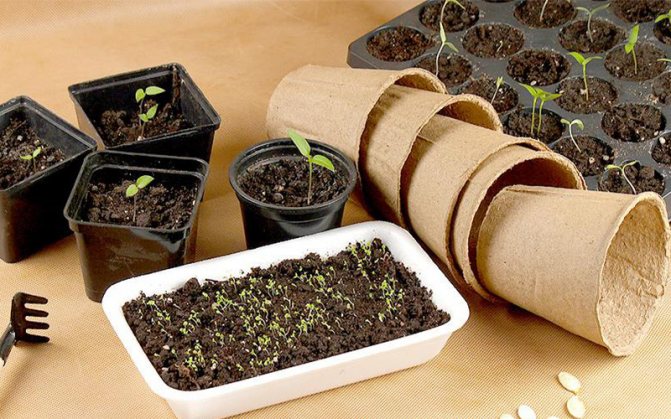

According to the lunar calendar, sowing in 2019 should be done on the following days:
- March - 8-13, 17, 23-25.
- April - 7-13, 16, 22-24.
- May - 8-14, 17, 23-26.
- June - 5-11, 15, 20-22.
- July - 4-10, 14, 19-21.
- August - 3-9, 13, 18-20.
- September - 2-8, 12, 17-19, 30.
- October - 4-7, 15-18.
Soil and container for sowing seeds
The seeds of primroses are very small, the seedlings are tender, so the soil should be light so that the roots can grow comfortably in it. To create one, buy ordinary seedling soil in a store of a brand you have already tested, and add 1/4 to 1/3 of the total volume of vermiculite to it. Experienced flower growers recommend creating a top layer for crops with a thickness of 2-3 cm from one vermiculite or washed coarse sand.
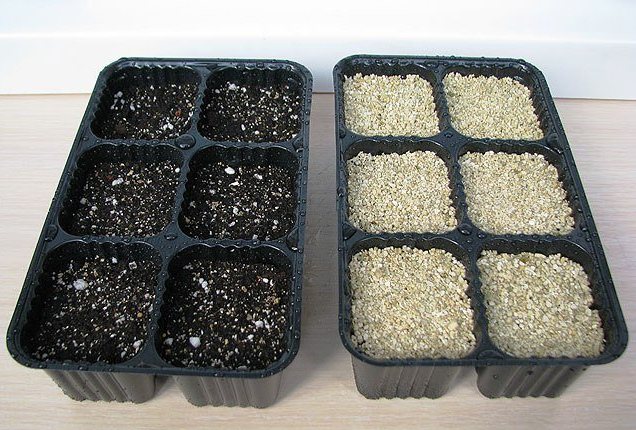

Soil for primroses is recommended and mixed with vermiculite, and sprinkle with it
As for the container, bowls, plastic containers, boxes, pots 7-10 cm deep are suitable. If there are no drainage holes in the bottom, be sure to make them. Rinse reused containers with soap or baking soda before filling with soil.
Unusual flowers - ear primroses
- Auricular primroses, or auricles (Auricula) - an extensive group of garden forms and varieties of the genus Primula (Primula). A wild species that became the basis for breeding is the ear primrose (P. auricula) from Central and Southern Europe.
- They are short plants with thick rhizomes and fleshy leathery leaves. Peduncles and flowers are covered with a white powdery bloom. The petals are pink, lilac, purple, yellow, often with a light eye.
- Auricles are especially loved in England, where they have been collectable plants since the 16th century. Over the past centuries, an incredible number of varieties and forms of ear primroses have been obtained in Britain: terry, variegated two-, three-flowered, iridescent mother-of-pearl, with exotic colored petals.
- Auricles can be successfully grown in gardens and parks in central Russia. They are quite winter-hardy and unpretentious. Growing auricular primrose requires a sunny or semi-shady location, loose, nutritious garden soil with good drainage.
- In spring - early summer, watering is especially important when there is a lack of soil moisture. Auricular primroses bloom in spring - early summer.They propagate well by seeds, that is, primrose ear cultivation from seeds is excellent, while the flowers bloom for 2 - 3 years and vegetatively - with segments of rhizomes.
Primula stemless, or ordinary (Primula acaulis, syn. P vulgaris), in nature - a small herb that gave the name to the family. The leaves are simple, the flowers are solitary, most often white or yellow, less often pink, purple or purple with an eye.
One of the first to bloom in early spring. Often on a plant in bloom, you cannot even see the leaves - they are covered with numerous flowers. From other primroses stemless and its hybrids are easy to distinguish - the flowers are always solitary, not collected in an inflorescence, each on its own stalk.
These unpretentious plants are not uncommon in gardens. The best way to get primroses is to ask neighbors and friends for clones that have been growing well for a long time.
You can buy flowering specimens - then both the type and the variety will not be in doubt.
In winter, primroses rhizomes are sometimes sold. They can be bought and stored for a short time in sphagnum in the zero chamber of the refrigerator.
If they grow prematurely, they need to be planted in pots and kept on a cool loggia. In a room with a high temperature and low air humidity, planted primroses are likely to die.
Sometimes on sale you can see seeds of terry primroses (for example, the Rosanna variety-series).
However, if you look closely at the picture, and then at the living flower, it turns out that there are still five petals, they just have a wavy edge and they are not fully opened, which is why the middle is not visible and the flower looks double.
True double (multi-petal, without stamens and pistil) flowers are sterile. Terry varieties can only be propagated vegetatively. These are also available in stemless primroses.
New varieties appear every year, it is often difficult to understand what is sustainable and what is not. In general, resistant primrose clones are:
- as close as possible to the natural species in color and size of flowers;
- pastel colors, not blue;
- without large bracts (“collar” of leaves immediately under the flower).
Planting and caring for common primrose (stemless)
Resistant varieties of stemless primrose - plants that last when growing, plastic and tolerant to the vicissitudes of garden life.
The best time to plant primroses is as soon as the snow melts, but if there is watering, they endure division and transplanting at any time convenient for you. Primroses take root at low temperatures (planted in late summer - autumn, they often bulge out after wintering).
Ideally, such primroses need partial shade with rich loamy soil, good nutrition (for abundant flowering), and the absence of both locking and drying out. But they will also tolerate full sun (subject to guaranteed watering).
Leaving primrose almost does not require.
It is useful to clean them from dead leaves after the snow melts, water them in the heat, fertilize them with complex fertilizer according to the season, and mulch. Poor wintering is usually characteristic of unstable varieties and when planted in a damp place.
First of all, blue and large-flowered ones fall out. The species are very stable and can withstand any snowless winters for me. It makes no sense to shelter primroses: they get wet more often than freeze, and this will happen much faster under cover.


